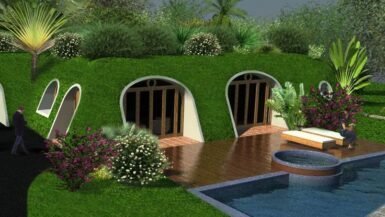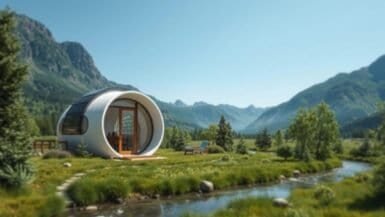In today’s ever-evolving world, the concept of sustainable living has gained significant momentum, with more and more people seeking innovative ways to minimize their ecological footprint. One such solution that has been garnering attention is the integration of tiny homes with greenhouses. In this article, we delve into the numerous benefits that come with living in such a combined dwelling, touching upon aspects like reduced energy consumption, self-sufficiency, and the psychological benefits of being closely connected to nature. As we explore how these tiny homes with greenhouses are redefining the way we think about sustainable living, we invite you to join us on a journey towards a more eco-friendly and harmonious lifestyle.
Maximizing Space: Combining Tiny Homes and Greenhouses for Sustainable Living
The marriage of tiny homes and greenhouses is a perfect example of how innovative design can lead to more efficient and sustainable living spaces. By thoughtfully integrating greenhouses into tiny home designs, it is possible to maximize the utilization of space while minimizing the environmental impact. In this section, we will delve into the various ways in which combining tiny homes with greenhouses can help you make the most of your living space and contribute to a greener planet.
Multi-functional Living Areas
One of the most significant advantages of incorporating a greenhouse into a tiny home design is the creation of multi-functional living areas. By using a greenhouse as an extension of your living space, you can effectively increase the square footage of your home without increasing your ecological footprint. This additional area can serve as a relaxing spot to unwind, an area for cultivating plants, or even a space to entertain guests, all while being surrounded by nature.
Year-Round Food Production
Having a greenhouse attached to a tiny home allows you to grow your food throughout the year, regardless of the climate. This means that you can enjoy fresh, organic produce without relying on industrial agriculture, which contributes significantly to greenhouse gas emissions. Additionally, growing your food reduces the need for transportation, packaging, and storage, further reducing your environmental impact.
Improved Insulation and Passive Heating
A well-designed greenhouse can provide excellent insulation for your tiny home, helping to regulate indoor temperatures and reduce heating and cooling costs. During the colder months, the greenhouse can act as a passive solar heater, absorbing sunlight and transferring the heat to the adjacent living space. Conversely, in warmer months, the greenhouse can be used as a shading device to keep your tiny home cool and comfortable.
Waste Minimization and Recycling
Incorporating a greenhouse into your tiny home design can also help you minimize waste and promote recycling. For instance, kitchen scraps can easily be composted and used as nutrient-rich fertilizer for your plants. Similarly, greywater from your home can be filtered and reused for irrigating your greenhouse, conserving valuable water resources.
Enhanced Connection with Nature
Finally, living in a tiny home with an attached greenhouse fosters a deep connection with nature. This close relationship with the natural world can have profound psychological benefits, promoting well-being and reducing stress. Furthermore, this intimate connection can inspire you to live a more environmentally conscious lifestyle, making choices that positively impact the planet.
As we can see, combining tiny homes with greenhouses offers numerous benefits for sustainable living. By maximizing space, promoting self-sufficiency, and reducing our environmental impact, these innovative dwellings are paving the way towards a greener future.
Healthier Lifestyle: How Tiny Home Greenhouses Improve Indoor Air Quality
Living in a tiny home with an attached greenhouse not only offers numerous benefits in terms of sustainability and efficiency but also significantly contributes to a healthier lifestyle. One important aspect of this healthy living is the improvement in indoor air quality, which is vital for our well-being. In this section, we explore the various ways in which tiny home greenhouses enhance the air quality within your living space, leading to a healthier and happier life.
Natural Air Purification
Plants are known for their ability to purify the air by absorbing harmful pollutants and releasing clean oxygen through the process of photosynthesis. By cultivating a variety of plants in your tiny home greenhouse, you can create a natural air purification system that effectively filters out harmful toxins and chemicals from the indoor air, ensuring that you and your family breathe clean, fresh air at all times.
Humidity Regulation
Maintaining optimal humidity levels is crucial for a healthy indoor environment, as it helps prevent the growth of mold and mildew, which can lead to respiratory problems and allergies. Greenhouses, by design, help regulate humidity levels within the attached living space. As plants release moisture through a process called transpiration, the greenhouse environment becomes more humid, providing a natural way to maintain comfortable humidity levels within your tiny home.
Reduced Volatile Organic Compounds (VOCs)
Volatile Organic Compounds (VOCs) are harmful chemicals that are released into the air from everyday household items, such as paints, cleaning products, and furniture. Living in a tiny home with a greenhouse can help reduce the concentration of VOCs in your indoor air, as many plants are known to absorb and neutralize these harmful chemicals. Moreover, the abundance of natural light in a greenhouse can help break down VOCs, further contributing to cleaner air.
Improved Ventilation
Proper ventilation is essential for maintaining good indoor air quality, as it allows for the circulation of fresh air and the removal of stale air. A well-designed tiny home greenhouse can contribute to improved ventilation by allowing for the free flow of air between the greenhouse and the living space. This constant circulation of air ensures that your indoor environment remains fresh and healthy.
Boosting Mental Health
Lastly, the presence of a greenhouse in your tiny home can have significant positive effects on your mental health. Surrounding yourself with plants and nature can help reduce stress, anxiety, and depression, leading to an overall improvement in your well-being. Furthermore, engaging in gardening activities within your greenhouse can serve as a therapeutic and relaxing hobby, further contributing to a healthier lifestyle.
To sum up, integrating a greenhouse into your tiny home design can significantly enhance the indoor air quality and contribute to a healthier lifestyle. By providing natural air purification, humidity regulation, reduced VOCs, improved ventilation, and a positive impact on mental health, tiny home greenhouses offer an excellent solution for those seeking a sustainable and healthy living environment.
Homegrown Harvest: Producing Your Own Food with a Tiny Home Greenhouse
Embracing the concept of a tiny home with an attached greenhouse not only promotes sustainable living but also allows you to enjoy the benefits of growing your own food. The ability to cultivate fresh, organic produce right outside your door is both empowering and rewarding. In this section, we will discuss the various aspects of producing your own food with a tiny home greenhouse, highlighting the advantages such a setup offers in terms of nutrition, self-sufficiency, and environmental impact.
Fresher, More Nutritious Produce
One of the most significant benefits of growing your food in a tiny home greenhouse is the ability to enjoy fresher, more nutritious produce. Harvesting fruits and vegetables straight from your greenhouse ensures that you are consuming them at their peak ripeness, leading to better flavor and higher nutrient content. In contrast, store-bought produce often loses a considerable amount of its nutritional value during transportation and storage.
Reduced Pesticide Exposure
By cultivating your fruits and vegetables in a controlled environment, such as a greenhouse, you can minimize your exposure to harmful pesticides and chemicals commonly used in conventional agriculture. Growing your food allows you to choose organic and natural alternatives to manage pests and diseases, resulting in healthier and safer produce for you and your family.
Increased Food Security and Self-Sufficiency
Having a tiny home greenhouse enables you to produce a constant supply of fresh vegetables and herbs, increasing your food security and self-sufficiency. This can be particularly beneficial during times of unforeseen circumstances, such as natural disasters or economic hardships, when access to fresh produce may be limited or expensive.
Environmental Stewardship
Producing your food in a tiny home greenhouse contributes to a more sustainable lifestyle and reduces your carbon footprint. By growing your fruits and vegetables, you help decrease the demand for industrially-produced food, which is associated with high levels of greenhouse gas emissions, deforestation, and water pollution. Additionally, growing your food locally reduces the need for transportation, packaging, and storage, further minimizing your environmental impact.
Therapeutic Benefits of Gardening
Beyond the practical advantages of producing your food, gardening in your tiny home greenhouse offers therapeutic benefits that can enhance your overall well-being. Tending to your plants and watching them grow can provide a sense of accomplishment and satisfaction, while the physical activity involved in gardening promotes physical fitness and mental relaxation.
The integration of a greenhouse within a tiny home offers the opportunity to enjoy the benefits of homegrown harvests. By producing your food, you can enjoy fresher, healthier, and more nutritious produce, reduce your exposure to harmful pesticides, and increase your self-sufficiency. Furthermore, growing your food in a tiny home greenhouse contributes to environmental stewardship and provides therapeutic benefits, making it a rewarding and fulfilling endeavor for those seeking a more sustainable and self-reliant lifestyle.
Energy Efficiency: Eco-Friendly Advantages of Tiny Homes with Greenhouses
One of the most compelling reasons to consider a tiny home with an attached greenhouse is the potential for increased energy efficiency. By utilizing various design elements and innovative technologies, these combined dwellings can significantly reduce energy consumption and greenhouse gas emissions. In this section, we explore the key aspects of energy-efficient tiny homes with greenhouses, highlighting the eco-friendly advantages that make them an ideal choice for sustainable living.
Passive Solar Design for Optimal Temperature Regulation
A well-designed tiny home greenhouse can take advantage of passive solar design principles to optimize temperature regulation within the living space. By strategically positioning windows, skylights, and building materials, the greenhouse can effectively absorb and retain heat during the colder months while providing shade and ventilation during warmer weather. This results in a more comfortable indoor environment without relying heavily on energy-intensive heating and cooling systems.
Integration of Renewable Energy Sources
Tiny homes with greenhouses can be designed to incorporate renewable energy sources, such as solar panels or wind turbines, to power the home and greenhouse systems. By generating clean, renewable energy on-site, these dwellings can significantly reduce their reliance on fossil fuels, thereby lowering their carbon footprint and contributing to a more sustainable future.
Energy-Efficient Appliances and Lighting
Incorporating energy-efficient appliances and lighting fixtures into a tiny home with a greenhouse can further reduce energy consumption. By selecting ENERGY STAR-rated appliances and LED lighting, homeowners can minimize their energy usage and associated greenhouse gas emissions without compromising on convenience or functionality.
Greenhouse-Enhanced Insulation and Thermal Mass
The integration of a greenhouse with a tiny home can provide additional insulation and thermal mass, helping to maintain stable indoor temperatures throughout the year. The greenhouse can act as a buffer zone between the indoor living space and the outdoor environment, reducing heat loss during the winter and heat gain during the summer. This, in turn, helps to decrease the energy required for heating and cooling, resulting in a more energy-efficient and eco-friendly dwelling.
Water Conservation through Greywater Recycling
Tiny homes with greenhouses can also incorporate water-saving features, such as greywater recycling systems, to conserve valuable water resources. Greywater from household activities, such as showering and washing dishes, can be filtered and reused for irrigating the greenhouse plants, reducing the overall water consumption and minimizing the environmental impact.
The combination of a tiny home and a greenhouse offers numerous energy-efficient and eco-friendly advantages, making it an attractive option for those seeking a more sustainable lifestyle. By incorporating passive solar design, renewable energy sources, energy-efficient appliances, enhanced insulation, and water conservation measures, these innovative dwellings can significantly reduce their environmental footprint while providing a comfortable and functional living space.
Embracing Biophilic Design: Integrating Nature into Tiny Home Living Spaces
The concept of biophilic design revolves around creating a strong connection between humans and nature within the built environment. By integrating natural elements into tiny home living spaces, homeowners can enjoy an enhanced quality of life, improved mental well-being, and a deeper appreciation for the natural world. In this section, we will explore the various ways in which biophilic design principles can be incorporated into tiny homes with greenhouses, resulting in a harmonious and nurturing living space that fosters a strong bond with nature.
Indoor-Outdoor Connectivity
One of the key aspects of biophilic design is the seamless integration of indoor and outdoor spaces, allowing for an effortless flow between the two. In a tiny home with a greenhouse, this can be achieved through the use of large windows, sliding glass doors, or even retractable walls, effectively blurring the boundaries between the living space and the greenhouse. This indoor-outdoor connectivity not only provides a constant visual connection to nature but also encourages occupants to engage with the natural world regularly.
Natural Materials and Textures
Incorporating natural materials and textures into the design of a tiny home with a greenhouse can further strengthen the connection between the occupants and nature. By using materials such as wood, stone, and bamboo for the structure, furniture, and decorative elements, homeowners can create an environment that evokes the beauty and serenity of the natural world, fostering a sense of calm and well-being.
Green Walls and Vertical Gardens
Green walls and vertical gardens are another innovative way to bring nature into tiny home living spaces. By covering interior or exterior walls with a variety of plants, homeowners can enjoy the benefits of increased air purification, enhanced visual appeal, and an overall improvement in mental health. Additionally, vertical gardens can help regulate indoor temperatures, contributing to a more energy-efficient and sustainable home.
Natural Light and Ventilation
Maximizing the use of natural light and ventilation within a tiny home with a greenhouse is essential for creating a healthy and comfortable living environment. By incorporating large windows, skylights, and well-placed openings, homeowners can ensure that their living space is filled with an abundance of natural light, while also promoting the circulation of fresh air. This not only reduces the reliance on artificial lighting and air conditioning systems but also fosters a stronger connection with the rhythms of the natural world.
Water Features
Integrating water features into a tiny home with a greenhouse can further enhance the biophilic design and create a soothing atmosphere. The calming sound of a small water fountain or a tabletop water garden can provide a sense of tranquility and relaxation while also promoting a sense of connection with the natural world.
By embracing biophilic design principles and integrating nature into tiny home living spaces, homeowners can create a nurturing and harmonious environment that fosters a deep connection with the natural world. Through indoor-outdoor connectivity, the use of natural materials, green walls, natural light and ventilation, and water features, tiny homes with greenhouses can provide occupants with a truly unique and holistic living experience, promoting mental well-being and a more sustainable lifestyle.





Leave a reply